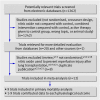Effect of nitric oxide on oxygenation and mortality in acute lung injury: systematic review and meta-analysis
- PMID: 17383982
- PMCID: PMC1852043
- DOI: 10.1136/bmj.39139.716794.55
Effect of nitric oxide on oxygenation and mortality in acute lung injury: systematic review and meta-analysis
Abstract
Objective: To review the literature on the use of inhaled nitric oxide to treat acute lung injury/acute respiratory distress syndrome (ALI/ARDS) and to summarise the effects of nitric oxide, compared with placebo or usual care without nitric oxide, in adults and children with ALI or ARDS.
Design: Systematic review and meta-analysis.
Data sources: Medline, CINAHL, Embase, and CENTRAL (to October 2006), proceedings from four conferences, and additional information from authors of 10 trials.
Review methods: Two reviewers independently selected parallel group randomised controlled trials comparing nitric oxide with control and extracted data related to study methods, clinical and physiological outcomes, and adverse events.
Main outcome measures: Mortality, duration of ventilation, oxygenation, pulmonary arterial pressure, adverse events.
Results: 12 trials randomly assigning 1237 patients met inclusion criteria. Overall methodological quality was good. Using random effects models, we found no significant effect of nitric oxide on hospital mortality (risk ratio 1.10, 95% confidence interval 0.94 to 1.30), duration of ventilation, or ventilator-free days. On day one of treatment, nitric oxide increased the ratio of partial pressure of oxygen to fraction of inspired oxygen (PaO2/FiO2 ratio) (13%, 4% to 23%) and decreased the oxygenation index (14%, 2% to 25%). Some evidence suggested that improvements in oxygenation persisted until day four. There was no effect on mean pulmonary arterial pressure. Patients receiving nitric oxide had an increased risk of developing renal dysfunction (1.50, 1.11 to 2.02).
Conclusions: Nitric oxide is associated with limited improvement in oxygenation in patients with ALI or ARDS but confers no mortality benefit and may cause harm. We do not recommend its routine use in these severely ill patients.
Conflict of interest statement
Figures






Comment in
-
Inhaled nitric oxide for acute respiratory distress syndrome.BMJ. 2007 Apr 14;334(7597):757-8. doi: 10.1136/bmj.39168.568692.BE. BMJ. 2007. PMID: 17431232 Free PMC article.
References
-
- Bernard GR, Artigas A, Brigham KL, Carlet J, Falke K, Hudson L, et al. The American-European Consensus Conference on ARDS. Definitions, mechanisms, relevant outcomes, and clinical trial coordination. Am J Respir Crit Care Med 1994;149:819-24. - PubMed
-
- Ware LB, Matthay MA. The acute respiratory distress syndrome. N Engl J Med 2000;342:1334-49. - PubMed
-
- Furchgott RF. The 1996 Albert Lasker Medical Research Awards. The discovery of endothelium-derived relaxing factor and its importance in the identification of nitric oxide. JAMA 1996;276:1186-8. - PubMed
-
- Gries A, Bode C, Peter K, Herr A, Bohrer H, Motsch J, et al. Inhaled nitric oxide inhibits human platelet aggregation, P-selectin expression, and fibrinogen binding in vitro and in vivo. Circulation 1998;97:1481-7. - PubMed
Publication types
MeSH terms
Substances
LinkOut - more resources
Full Text Sources
Other Literature Sources
Miscellaneous
